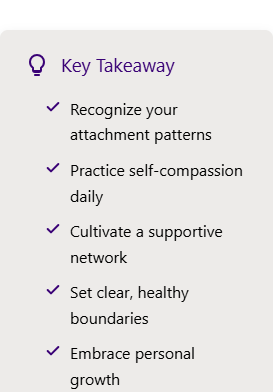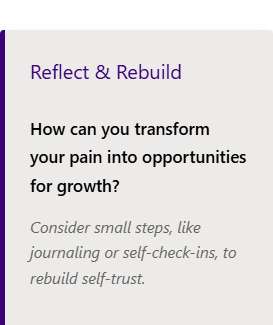Fearful Avoidant Breakup Recovery: Healing After Heartbreak

Navigating Abandonment
Healing and growth in coping with abandonment in fearful avoidant relationships
Introduction
When a relationship with a fearful avoidant partner ends suddenly, the emotional aftermath can feel overwhelming and deeply disorienting. Understanding the unique dynamics of fearful avoidant attachment can transform your healing journey from a painful experience into an opportunity for profound personal growth. This guide will walk you through navigating the complex emotional landscape of a sudden breakup, offering compassionate strategies to rebuild your sense of self and prepare for healthier future connections.
Understanding Fearful Avoidant Attachment Dynamics
Fearful avoidant attachment represents a complex psychological pattern where individuals simultaneously crave intimacy while feeling deeply afraid of emotional vulnerability.
- Defining Fearful Avoidant Attachment: Fearful avoidant attachment emerges from early life experiences where emotional needs were inconsistently met, creating a deep-seated fear of both intimacy and abandonment. These individuals oscillate between intense desire for connection and profound anxiety about being emotionally hurt.
- Relationship Behavior Patterns: People with fearful avoidant attachment often create relationship dynamics characterized by push-pull behaviors. They simultaneously desire closeness while unconsciously sabotaging connections through emotional withdrawal, creating a cycle of turbulent and unpredictable relationships.
- Impact on Relationship Stability: The inherent contradiction in fearful avoidant attachment – wanting intimacy while fearing vulnerability – makes relationships inherently unstable. Sudden breakups often occur when emotional intimacy becomes too overwhelming, triggering deep-seated abandonment fears.
Practical Actions:
- Recognize that your partner’s behavior reflects their internal emotional struggle, not your inherent worth.
- Understand that sudden breakups in fearful avoidant relationships are more about their internal fears than your actions.
- Begin documenting your emotional patterns to develop greater self-awareness.
Remember: Fearful avoidant attachment is a learned response, not a personal failure. By understanding these dynamics, you can cultivate compassion for yourself and your past relationship.
Your attachment style is a learned response, not an immutable destiny. Transformation begins with self-compassion and understanding.
Fearful Avoidant Breakup Recovery: Navigating Emotional Aftermath of Sudden Breakup
A sudden breakup triggered by fearful avoidant attachment can create profound emotional disruption, requiring intentional healing strategies.
- Immediate Emotional Response: The initial shock of a sudden breakup can trigger intense emotions ranging from profound grief to disbelief. Recognize that these feelings are valid and represent a natural response to unexpected loss and potential reactivation of past attachment wounds.
- Processing Abandonment Fears: The initial shock of a sudden breakup can trigger intense emotions ranging from profound grief to disbelief. Recognize that these feelings are valid and represent a natural response to unexpected loss and potential reactivation of past attachment wounds.
- Long-Term Emotional Impact: The psychological aftermath of a fearful avoidant breakup extends beyond immediate grief, potentially influencing future relationship patterns. Recognizing and addressing these long-term implications is crucial for developing healthier attachment strategies.
Practical Actions:
- Understanding Attachment Styles can provide crucial context for your healing journey.
- Create a structured emotional support plan involving trusted friends, family, or professional counseling.
- Practice mindfulness techniques to stay grounded during intense emotional periods.
Remember: Healing is not linear. Each emotional wave brings an opportunity for deeper self-understanding and personal transformation.


Fearful Avoidant Breakup Recovery: Rebuilding and Transforming After Breakup
Recovery from a fearful avoidant relationship breakup involves deliberate strategies for personal growth and developing secure attachment patterns.
- Self-Compassion Practices: Developing self-compassion is crucial in healing from a fearful avoidant breakup. This involves acknowledging your pain without judgment, treating yourself with kindness, and recognizing that your worth is not determined by relationship outcomes.
- Developing Secure Attachment Skills: Transforming attachment patterns requires intentional work. This includes recognizing unhealthy relationship dynamics, developing clear personal boundaries, and practicing emotional vulnerability in controlled, safe environments.
- Professional Support and Resources: Seeking professional guidance can accelerate healing. Building a Support System provides structured approaches to emotional recovery and developing healthier relationship patterns.
Practical Actions:
- Use The Love Deserved: Guided Journal to document your healing journey.
- Engage in therapy or support groups specializing in attachment-based healing.
- Develop a personal growth plan that prioritizes emotional well-being.
Remember: Your breakup is not an endpoint, but a transformative moment in your personal narrative. Each step towards healing is a step towards a more authentic, resilient version of yourself.
Conclusion
Recovering from a fearful avoidant breakup is a profound journey of self-discovery. While the pain may feel overwhelming, it carries the potential for significant personal growth. By understanding attachment patterns, processing emotions compassionately, and actively working on personal development, you can transform this challenging experience into a powerful catalyst for healing. Remember, your past does not dictate your future – each moment offers an opportunity to rewrite your emotional narrative and create more fulfilling, secure relationships.